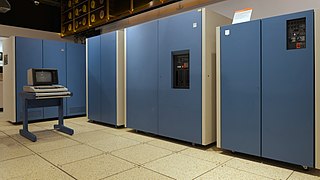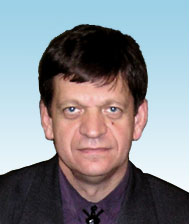Related Research Articles

The IBM 4300 series were mid-range systems compatible with System/370 that were sold from 1979 through 1992. They featured modest electrical and cooling requirements, and thus did not require a data center environment. They had a disruptive effect on the market, allowing customers to provide internal IBM computing services at a cost point lower than commercial time-sharing services. All 4300 processors used a 3278-2A, 3279-C or 3205 display console rather than a 3210 or 3215 keyboard/printer console.

Interval arithmetic is a mathematical technique used to put bounds on rounding errors and measurement errors in mathematical computation. Numerical methods using interval arithmetic can guarantee reliable, mathematically correct results. Instead of representing a value as a single number, interval arithmetic represents each value as a range of possibilities. For example, instead of estimating the height of someone as exactly 2.0 metres, using interval arithmetic one might be certain that the person is somewhere between 1.97 and 2.03 metres.

Friedrich Ludwig "Fritz" Bauer was a German pioneer of computer science and professor at the Technical University of Munich.
A computer-assisted proof is a mathematical proof that has been at least partially generated by computer.

The Interdisciplinary Center for Scientific Computing is a scientific research institute of the Heidelberg University, Germany. It centralizes scientific activity and promotes research and work in scientific computing. Founded in 1987 by the Heidelberg University and the state of Baden-Württemberg, IWR participates in joint project and cooperations with industry in Germany as well as abroad. As a research institute with about 380 staff, IWR is considered one of the world's largest research centers for scientific computing.
Klaus Samelson was a German mathematician, physicist, and computer pioneer in the area of programming language translation and push-pop stack algorithms for sequential formula translation on computers.
Willard L. Miranker was an American mathematician and computer scientist, known for his contributions to applied mathematics and numerical mathematics.

Miodrag S. Petković is a mathematician and computer scientist. In 1991 he became a full professor of mathematics at the Faculty of Electronic Engineering, University of Niš in Serbia.
Gal's accurate tables is a method devised by Shmuel Gal to provide accurate values of special functions using a lookup table and interpolation. It is a fast and efficient method for generating values of functions like the exponential or the trigonometric functions to within last-bit accuracy for almost all argument values without using extended precision arithmetic.

Vladik Kreinovich is a professor of computer science at the University of Texas at El Paso.
Unums are a family of formats and arithmetic, similar to floating point, proposed by John L. Gustafson. They are designed as an alternative to the ubiquitous IEEE 754 floating-point standard and the latest version can be used as a drop-in replacement for programs which do not depend on specific features of IEEE 754.
Karlsruhe Accurate Arithmetic (KAA) or Karlsruhe Accurate Arithmetic Approach (KAAA), augments conventional floating-point arithmetic with good error behaviour with new operations to calculate scalar products with a single rounding error.
Validated numerics, or rigorous computation, verified computation, reliable computation, numerical verification is numerics including mathematically strict error evaluation, and it is one field of numerical analysis. For computation, interval arithmetic is used, and all results are represented by intervals. Validated numerics were used by Warwick Tucker in order to solve the 14th of Smale's problems, and today it is recognized as a powerful tool for the study of dynamical systems.

Alwin Oswald Walther was a German mathematician, engineer and professor. He is one of the pioneers of mechanical computing technology in Germany.

Rolf Rannacher is a German mathematician and a professor of numerical analysis at Heidelberg University.

Helmut Schwichtenberg is a German mathematical logician.
INTLAB is an interval arithmetic library using MATLAB and GNU Octave, available in Windows and Linux, macOS. It was developed by S.M. Rump from Hamburg University of Technology. INTLAB was used to develop other MATLAB-based libraries such as VERSOFT and INTSOLVER, and it was used to solve some problems in the Hundred-dollar, Hundred-digit Challenge problems.

The ERMETH was one of the first computers in Europe and was developed and built by Eduard Stiefel and his team of the Institute for Applied Mathematics at the ETH Zurich between 1948 and 1956. It was in use until 1963 and is now displayed at the Museum for Communication in Bern (Switzerland).

Günther Hans Frei is a Swiss mathematician and historian of mathematics.